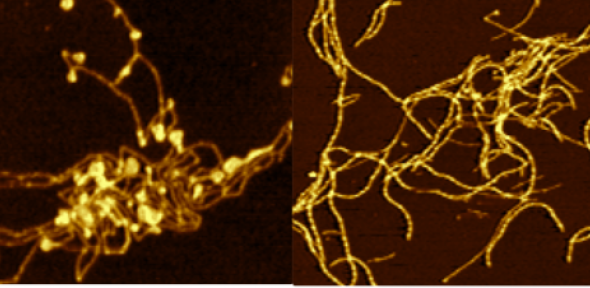
AFM image courtesy Patrick Flagmeier
Researchers in the department have discovered that specific mutations in the protein associated with Parkinson’s disease can make a dramatic difference to how the protein aggregates and therefore might alter how the condition develops.
The team of academics from the department's Centre for Misfolding Diseases showed that changes in the amino acid sequence of the protein alpha-synuclein can significantly impact the microscopic processes that lead to its malfunctioning in the brain, which may eventually result in Parkinson’s Disease.
Under normal circumstances alpha-synuclein plays an important part in helping with the smooth flow of chemical signals in the brain. But Parkinson’s Disease is thought to arise when this protein misfolds and begins to cluster, creating toxic, threadlike structures known as amyloid fibrils, or Lewy-bodies in the case of Parkinson’s.
The team studied mutated forms of alpha-synuclein which have been found in families with a history of Parkinson’s disease. In all cases, the mutations involved just one change to the protein’s amino acid sequence.
Although the differences in the sequence were small, the researchers found they had a profound effect on how quickly or slowly the amyloid fibrils began to form. They also found that the mutations influence a process called ‘secondary nucleation’, in which new fibrils form at the surface of existing ones, enabling the disease to spread.
The study’s lead author, PhD student Patrick Flagmeier, said: “As a finding, it helps us to understand fundamental things about the system by which this disease emerges. In the end, if we can understand all of this better, that can help us to develop therapeutic strategies to confront it.”
The researchers stressed that these results do not explain why humans get the disease, which has multiple, complex causes, and is not always related to alpha-synuclein mutations.
However, where the mutations are involved, the study opens the door to understanding, for the first time, how they can have such a dramatic impact on very particular stages of the process.
“The effects we observed were changes of several orders of magnitude and it was unexpected to observe such dramatic effects from single-point mutations,” said Flagmeier.
Dr Alexander Buell, also at the CMD and a senior author of the study, said: “We have only recently discovered the amplification process of alpha-synuclein fibrils, and the results of the present study will help us to understand in much more detail the mechanism behind this process, and in what ways it differs from the initial formation of aggregates.”
Dr Céline Galvagnion, senior author and also at the CMD said: “This study correlates individual changes in the amino acid sequence of alpha-synuclein with its tendency to aggregate. However, the effect of these mutations on other parameters such as the loss of the protein's function needs to be taken into account to fully understand the link between the familial mutations of alpha-synuclein and the onset of Parkinson's Disease."
Addressing these problems represents the core programme of research of the Centre for Misfolding Diseases, which is directed by Chris Dobson, Tuomas Knowles and Michele Vendruscolo. The primary mission of the Centre is to develop a fundamental understanding of the molecular origins of the variety of disorders associated with the misfolding and aggregation of proteins, which include Parkinson's disease, ALS and type II diabetes as well as Alzheimer's disease, and then to use such understanding for the rational design of novel therapeutic strategies.
This article was adapted from a longer article on the University of Cambridge website.
